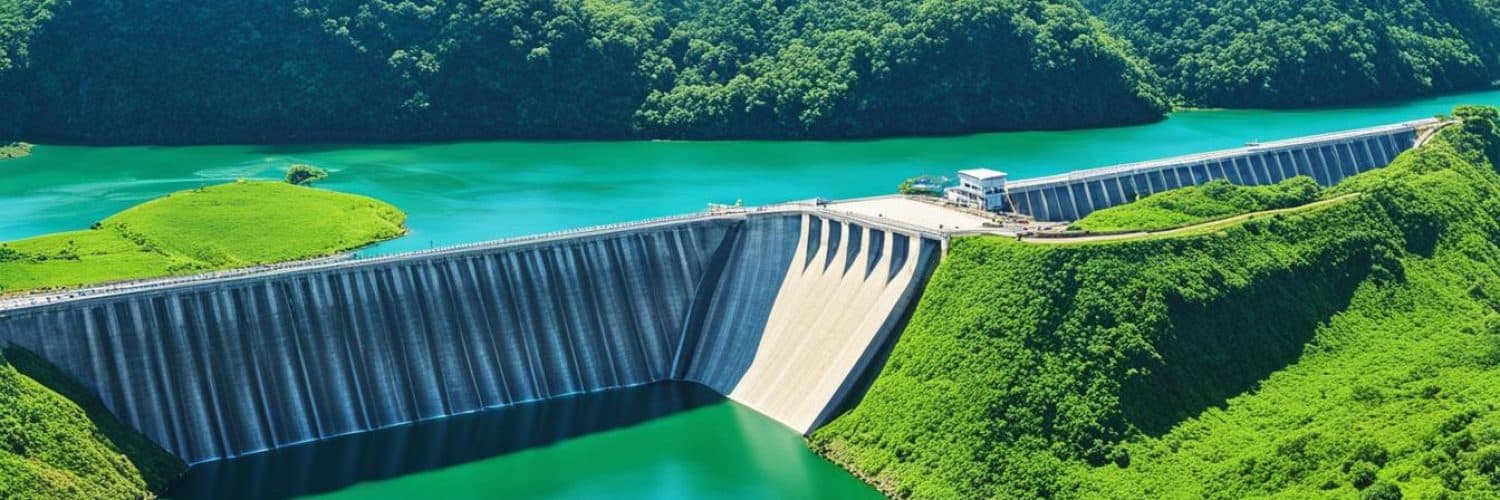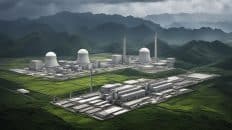Welcome to our comprehensive guide on the Angat Dam, a vital water resource located in Bulacan, Philippines. This remarkable dam serves a multitude of purposes, including water supply, hydroelectric power generation, irrigation, flood control, and even serves as a tourism spot. Let’s explore the significance of Angat Dam and its various functions.
Key Takeaways:
- Angat Dam, located in Bulacan, is a crucial water resource for the region.
- It provides water supply, hydroelectric power, irrigation, flood control, and serves as a tourism attraction.
- The dam’s construction is crucial for meeting the water needs of Metropolitan Manila and the surrounding areas.
- Proper water conservation efforts are essential to ensure sustained water supply in water-deficient areas.
- The reservoir created by the dam helps minimize flood destruction in the region.
Location and Function of Angat Dam
The Angat Dam is strategically located in San Lorenzo, Norzagaray, Bulacan, approximately 60 kilometers north of Metropolitan Manila. Constructed between 1961 and 1967, this impressive dam serves multiple functions that contribute to the overall development and sustainability of the region.
One of the key functions of the Angat Dam is power generation. With a commendable capacity of 246,000 KW, the dam generates electricity that is supplied to the Luzon Grid, meeting the power needs of numerous areas in the region.
Additionally, the reservoir created by the Angat Dam plays a crucial role in irrigation. It provides water to approximately 30,000 hectares of rice land in Bulacan, enabling the growth and sustenance of agricultural activities in the area.
The Angat Dam is also a vital component in flood control measures. By minimizing flood destruction, it protects the surrounding communities from the devastating impact of excessive rainfall. The dam acts as a barrier, regulating the flow of water and preventing widespread damage.
Furthermore, the Angat Dam has become a remarkable tourism attraction, thanks to its scenic landscape. Visitors are captivated by the beauty of the dam and its surroundings. The opportunity to witness this engineering marvel up close offers a unique and memorable experience.
Lastly, the Angat Dam serves as a crucial water supply source for Metropolitan Manila and the 18 municipalities within the MWSS franchise area. It provides a steady water supply that caters to the needs of these urbanized regions, ensuring water availability for both domestic and commercial purposes.
| Function | Location |
|---|---|
| Power Generation | Luzon Grid |
| Irrigation | Bulacan |
| Flood Control | Surrounding Communities |
| Tourism Attraction | San Lorenzo, Norzagaray, Bulacan |
| Water Supply | Metropolitan Manila, MWSS franchise area |
Structure of Angat Dam
The Angat Dam, located in San Lorenzo, Norzagaray, Bulacan, is an impressive example of an earth and rockfill dam. With a maximum height of 131 meters, it stands tall as a testament to engineering excellence and efficient water management.
The length at crest of the dam measures 568 meters, making it a significant structure. The widest section spans 550 meters, showcasing the dam’s scale and strength. Its impressive size allows for effective water storage and distribution.
The Angat Dam features an incline earth core as its impervious core, ensuring minimal seepage and maximum water retention. Its capacity is a remarkable 850 million cubic meters, providing a significant water supply for the region.
At the crest, the dam reaches an elevation of 223.5 meters at the middle and 221.5 meters at the abutment. This elevation difference allows for controlled water release and distribution throughout the dam system.
The dam’s slopes also play a crucial role in maintaining its integrity. The upstream slope has a ratio of 1 on 2.5, while the downstream slope performs at 1 on 1.35. These slopes ensure stability and prevent erosion from disrupting the dam’s structure.
To reinforce its strength, the Angat Dam incorporates large quantities of fill materials. It includes 880,000 cubic meters of impervious fill Earth core, 5,725,000 cubic meters of rockfill, and 464,000 cubic meters of filters. These materials work together to provide a solid foundation and efficient water containment.
The structure of the Angat Dam showcases the remarkable engineering involved in its creation. Its earth and rockfill design, maximum height, length at crest, capacity, elevation, slopes, and quantities of fill materials all contribute to its strength, reliability, and vital role in water management.
Water Supply from Angat Dam
The Angat Dam serves as a crucial water supply source for water-deficient areas, notably Metropolitan Manila and the 18 municipalities within the MWSS franchise area. It plays a vital role in ensuring sufficient water resources for the region’s growing population and various industries. The dam delivers approximately 935 million gallons of water daily, catering to the daily needs of millions of residents and businesses.
Metropolitan Manila, the bustling capital of the Philippines, heavily relies on the Angat Dam as its primary water source. The water supplied from the dam goes through an intricate network of pipelines and treatment facilities before reaching the taps of households and commercial establishments in the metropolitan area. This reliable water supply system helps meet the daily demands for drinking, cooking, and sanitation purposes.
The water from the Angat Dam is also crucial for sustaining various economic activities within Metropolitan Manila. Industries such as manufacturing, agriculture, and tourism heavily depend on a stable and sufficient water supply to operate effectively. The reliable water supply from the dam ensures the smooth functioning of these industries, driving economic growth and development in the region.
La Mesa Dam and Ipo Dam: Interconnected Water Supply System
The water supply system in Metro Manila operates as an interconnected network, with the Angat Dam playing a central role. The water sourced from the Angat Dam flows downstream to the Ipo Dam, located in Norzagaray, Bulacan. From there, it further travels to the La Mesa Dam, situated in Quezon City.
The La Mesa Dam acts as a critical reservoir and water treatment facility, supplying a significant portion of the water needs for the eastern side of Metro Manila. The treated water from the La Mesa Dam undergoes rigorous purification processes to ensure it meets the highest quality standards before distribution.
The interconnected water supply system between the Angat Dam, Ipo Dam, and La Mesa Dam allows for efficient water management and distribution across different parts of the metropolitan area. It ensures a consistent and reliable water supply to the residents of Metro Manila, mitigating water scarcity issues in this densely populated region.
Hydroelectric Power Generation at Angat Dam
The Angat Dam plays a crucial role in electricity generation through hydroelectric power. With a capacity of 246,000 KW, the dam harnesses the power of falling water to produce clean and sustainable energy.
This hydroelectric power generation is essential for the Luzon Grid, which supplies electricity to the surrounding areas. The Angat Dam contributes significantly to the overall power supply in the region, helping to meet the energy demands of homes, businesses, and industries.
By harnessing the force of water, the Angat Dam exemplifies the potential of renewable energy sources. It serves as a prime example of how hydroelectric power can contribute to a greener and more sustainable future for the Philippines.
“Hydroelectric power from the Angat Dam provides a reliable and renewable source of electricity for the Luzon Grid, reducing our dependence on fossil fuels and minimizing the environmental impact of power generation.”
– Environmentalist and Energy Advocate
Irrigation System Supported by Angat Dam
The Angat Dam plays a crucial role in supporting irrigation activities in Bulacan, specifically for approximately 30,000 hectares of rice land. The reservoir water from the dam is utilized to provide a stable water supply for rice farming in the region.
Rice farming is a vital agricultural practice in Bulacan, and the Angat Dam’s irrigation system ensures that farmers have access to the necessary water resources for their crops. With an extensive coverage of 30,000 hectares, the dam supports the growth of rice, a staple crop in the Philippines.
The irrigation system provided by the Angat Dam benefits farmers by ensuring that their rice crops receive sufficient water throughout the growing season. This system not only helps increase agricultural productivity but also contributes to food security in the region.
Benefits of the Irrigation System Supported by Angat Dam
The irrigation system supported by the Angat Dam offers numerous benefits to the local agricultural sector:
- Stable water supply: With water stored in the dam’s reservoir, farmers can depend on a consistent and reliable source of water for their rice crops.
- Increased crop yield: Access to irrigation water allows farmers to cultivate their rice fields optimally, leading to higher crop yields and improved quality of rice.
- Extended growing seasons: By providing water during dry periods, the irrigation system enables farmers to extend their growing seasons, maximizing their harvests.
- Reduced vulnerability to drought: In times of drought or water scarcity, the Angat Dam’s irrigation system helps mitigate the impact on rice farmers, ensuring their livelihoods are protected.
- Enhanced water efficiency: The irrigation system promotes efficient water usage by providing controlled water distribution that minimizes wastage and maximizes the effectiveness of irrigation practices.
Overall, the irrigation system supported by the Angat Dam plays a vital role in sustaining the agricultural activities in Bulacan and ensuring a stable water supply for rice farming. This, in turn, contributes to the local economy, food security, and the livelihoods of farmers in the region.
“The irrigation system provided by the Angat Dam has significantly improved our rice farming operations. We can now cultivate our fields with confidence, knowing that we have access to a consistent water supply. It has brought stability to our livelihoods and increased our crop yields.” – Jose Garcia, Local Rice Farmer
| Benefits | Description |
|---|---|
| Stable water supply | Reliable access to water for rice farming |
| Increased crop yield | Higher production and improved quality of rice |
| Extended growing seasons | Ability to cultivate crops for longer durations |
| Reduced vulnerability to drought | Protection against the impact of water scarcity |
| Enhanced water efficiency | Improved water usage and distribution |
Flood Control Measures by Angat Dam
One of the significant functions of the Angat Dam is flood control. The reservoir created by the dam helps to minimize flood destruction in the surrounding areas. This is particularly important during times of heavy rainfall and potential flooding. The dam acts as a barrier to control the flow of water and prevent extensive damage.
Floods can have catastrophic consequences, causing loss of life and property damage. The Angat Dam plays a crucial role in mitigating these risks and safeguarding the communities in the vicinity. By storing excessive water during heavy rains, the dam acts as a buffer, gradually releasing water to downstream areas to prevent sudden surges and flooding.
The Sierra Mountain Range, surrounding the Angat Dam, exacerbates the potential for flooding due to its steep slopes and natural drainage patterns. The reservoir efficiently manages the water flow, reducing the impact of torrential rains and preventing flash floods downstream.
The strategic location of the Angat Dam in the Sierra Mountain Range, combined with its comprehensive flood control measures, has proven to be instrumental in minimizing flood-related destruction. The dam’s reservoir capacity plays a vital role in attenuating floodwaters, protecting communities, infrastructure, and agricultural lands downstream.
“The Angat Dam’s flood control measures are crucial in preventing widespread devastation caused by floods. The reservoir acts as a buffer, storing excess water during heavy rainfall and releasing it gradually to prevent sudden floods. This helps protect lives and properties in the surrounding areas.” – Dr. Maria Santos, Environmental Scientist
The flood control function of the Angat Dam complements its other roles, such as water supply and power generation. By effectively managing water resources, the dam ensures a balance between meeting societal needs and minimizing environmental impacts.
Angat Dam as a Tourism Spot
The Angat Dam is not only a vital water resource but also a captivating tourism attraction. Visitors are enchanted by the breathtaking scenic landscape surrounding the dam, making it a picturesque destination worth exploring.
Exploring the dam site provides a unique opportunity to witness the magnitude of this engineering marvel up close. Visitors can indulge in leisurely sightseeing, capturing stunning photographs against the backdrop of the majestic dam.
The Angat Dam’s scenic beauty and tranquil surroundings make it an ideal spot for nature enthusiasts and photography enthusiasts alike. The serene ambiance and the vast expanse of water create a serene environment, allowing visitors to immerse themselves in the beauty of nature.
Visiting the Angat Dam offers a peaceful respite from the hustle and bustle of city life. The dam site serves as a serene oasis, inviting visitors to appreciate the wonders of nature’s creation.
Whether you are on a solo trip, a family vacation, or a leisurely outing, the Angat Dam promises a memorable experience. The harmonious blend of the dam’s architectural grandeur and the natural scenic landscape leaves a lasting impression on every visitor.
Don’t miss the chance to explore this captivating tourism gem and witness the Angat Dam’s magnificent beauty firsthand.
Water Conservation Efforts at Angat Dam
The Angat Dam plays a crucial role in water conservation efforts, particularly in water-deficient areas such as Metropolitan Manila. Proper management and sustainable use of water resources are essential to ensure a steady supply for both domestic and agricultural purposes. By implementing effective water conservation strategies, the Angat Dam contributes to addressing the water scarcity challenges faced by the region.
The reservoir of the Angat Dam allows for water storage during periods of abundant rainfall, providing a buffer supply in times of scarcity. This storage capacity is crucial in mitigating the impact of droughts and ensuring a sustainable water supply for the surrounding communities.
Furthermore, the dam facilitates water distribution through an extensive network of pipelines and channels. This enables the efficient allocation of water resources to various areas, prioritizing the needs of water-deficient regions. By optimizing water distribution, the Angat Dam promotes equitable access to water, minimizing the risk of water shortages in vulnerable communities.
The Angat Dam also collaborates with local stakeholders and communities to promote water conservation practices and raise awareness about the importance of sustainable water management. Educational campaigns and outreach programs are conducted to encourage responsible water usage, such as promoting the repair of leaky pipes, practicing water-efficient irrigation techniques, and implementing rainwater harvesting systems.
Sustainable Water Management Initiatives
The Angat Dam implements various initiatives to support sustainable water management in the region. These include:
- Implementing water recycling and reuse programs to minimize wastage and maximize the utilization of available water resources.
- Enforcing strict water use regulations to prevent excessive consumption and encourage responsible water usage.
- Investing in water infrastructure developments to enhance the efficiency of water distribution systems and minimize losses.
- Promoting environmental conservation efforts to protect water catchment areas and preserve the quality of water sources.
In conclusion, the Angat Dam’s commitment to water conservation and sustainable water management plays a vital role in addressing the water needs of water-deficient areas like Metropolitan Manila. Through efficient water storage, distribution, and collaborative efforts, the dam contributes to securing a reliable water supply for both present and future generations.
| Water Conservation Measures | Impact |
|---|---|
| Implementation of water recycling and reuse programs | Reduces water wastage and maximizes resource utilization |
| Enforcement of strict water use regulations | Promotes responsible water consumption and prevents excessive usage |
| Investment in water infrastructure developments | Enhances water distribution efficiency and minimizes losses |
| Promotion of environmental conservation efforts | Preserves water catchment areas and maintains water source quality |
Angat Dam’s Contribution to Water Supply and Control
The Angat Dam, located in Bulacan, Philippines, is a multi-purpose dam that plays a crucial role in various sectors, including water supply, flood control, power generation, irrigation, and tourism. It serves as a vital infrastructure in the region, supporting the development and sustainability of the area.
Water Supply
The Angat Dam is a significant source of water supply for water-deficient areas, particularly Metropolitan Manila and the 18 municipalities within the MWSS franchise area. With a capacity of approximately 850 million cubic meters, it ensures a steady supply of water for domestic, industrial, and agricultural purposes. The reservoir created by the dam provides a reliable source of water, contributing to the overall well-being and growth of the region.
Flood Control
Another crucial function of the Angat Dam is flood control. The reservoir acts as a barrier, controlling the flow of water and minimizing the risk of flood destruction in the surrounding areas. Particularly during periods of heavy rainfall and potential flooding, the dam’s infrastructure helps safeguard lives, properties, and critical infrastructure from the adverse effects of floods.
Power Generation
The Angat Dam generates hydroelectric power with a capacity of 246,000 kilowatts (KW). This power generation contributes significantly to the Luzon Grid, supplying electricity to the surrounding areas. The dam’s hydroelectric capabilities play a crucial role in meeting the region’s power demands and supporting economic activities.
Irrigation
The reservoir water from the Angat Dam supports irrigation systems, benefiting approximately 30,000 hectares of rice land in Bulacan. This ensures a stable water supply for agriculture, particularly for rice farming. The irrigation provided by the dam enhances agricultural productivity and sustains the livelihoods of farmers in the region.
Tourism
With its scenic landscape, the Angat Dam has become a popular tourist attraction. Visitors are drawn to the beautiful surroundings and the opportunity to witness a massive dam up close. The dam site offers scenic views, making it a favorite spot for sightseeing, photography, and appreciating the marvels of engineering and nature.
| Contributions | Key Sectors |
|---|---|
| Water Supply | Water-deficient areas, Metropolitan Manila, MWSS franchise area |
| Flood Control | Surrounding areas, minimizing flood destruction |
| Power Generation | Electricity supply to the Luzon Grid |
| Irrigation | Rice lands in Bulacan, supporting agriculture |
| Tourism | Scenic attraction, sightseeing, photography |
The multifunctional capabilities of the Angat Dam highlight its importance as a vital resource for water supply, flood control, power generation, irrigation, and tourism. Its contribution to the region’s growth and development cannot be overstated, making it an integral part of the local infrastructure.
Conclusion
The Angat Dam in Bulacan, Philippines, is a vital water resource and multifunctional dam that plays a crucial role in the region’s development and sustainability. With its capacity to provide water supply, hydroelectric power, irrigation, and flood control, the Angat Dam serves as a vital infrastructure for the area.
As a water resource, the dam ensures a steady supply of water for both domestic and agricultural needs, supporting the growth and well-being of the surrounding communities. Additionally, its hydroelectric power generation contributes to the Luzon Grid, providing electricity to the region and supporting various industries.
The Angat Dam’s irrigation system is instrumental in supporting rice farming in Bulacan, benefiting approximately 30,000 hectares of rice land. The dam also acts as a barrier against potential flooding, minimizing flood destruction and ensuring the safety of nearby areas.
Besides its functional importance, the Angat Dam has become a popular tourist attraction due to its scenic landscape. Visitors have the opportunity to appreciate the beauty of this vital infrastructure while enjoying activities such as sightseeing and photography.
In conclusion, the Angat Dam in Bulacan serves as a crucial water resource, multifunctional dam, and vital infrastructure for the region. Its capabilities and infrastructure contribute significantly to the development, sustainability, and efficient water management of the area.
FAQ
What is the function of the Angat Dam in Bulacan?
The Angat Dam serves multiple functions, including power generation, irrigation for rice lands in Bulacan, flood control, tourism attraction, and water supply to Metropolitan Manila and 18 municipalities within the MWSS franchise area.
Where is the Angat Dam located?
The Angat Dam is located in San Lorenzo, Norzagaray, Bulacan, about 60 kilometers north of Metropolitan Manila.
When was the Angat Dam completed?
The Angat Dam was completed in 1967.
What is the structure of the Angat Dam?
The Angat Dam is an earth and rockfill dam with a maximum height of 131 meters. It has an incline earth core as the impervious core and a capacity of 850 million cubic meters.
How does the Angat Dam contribute to water supply?
The Angat Dam plays a crucial role in water supply, providing approximately 935 million gallons of water daily to water-deficient areas such as Metropolitan Manila and the 18 municipalities within the MWSS franchise area.
What is the capacity of hydroelectric power generation at Angat Dam?
The Angat Dam has a hydroelectric power generation capacity of 246,000 KW, contributing to the power supply in the region.
What is the purpose of the Angat Dam’s irrigation system?
The Angat Dam’s reservoir water is utilized for irrigation purposes, specifically for approximately 30,000 hectares of rice land in Bulacan, supporting agricultural activities in the region.
How does the Angat Dam contribute to flood control?
The Angat Dam helps minimize flood destruction in the surrounding areas by acting as a barrier to control the flow of water during times of heavy rainfall and potential flooding.
Why is the Angat Dam considered a tourist attraction?
The Angat Dam has become a popular tourist attraction due to its scenic landscape, offering opportunities for sightseeing, photography, and appreciating the beauty of nature.
What is the role of the Angat Dam in water conservation?
The Angat Dam plays a crucial role in water conservation efforts, allowing for water storage and distribution to support sustainable water management in water-deficient areas.
How does the Angat Dam contribute to the overall development of the region?
The Angat Dam is a multifunctional dam that contributes significantly to water supply, flood control, power generation, irrigation, and tourism, supporting the overall development and sustainability of the area.


















Add comment